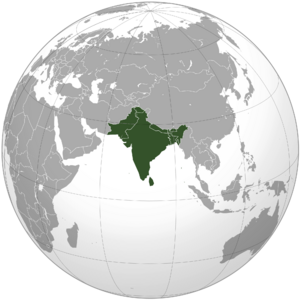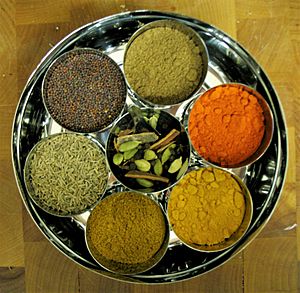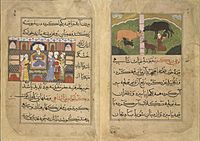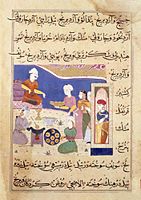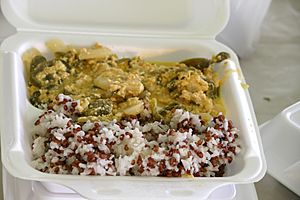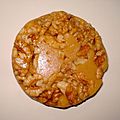Cuisine of the Indian subcontinent facts for kids
The cuisine of the Indian subcontinent includes the traditional foods from countries like Bangladesh, Bhutan, India, the Maldives, Nepal, Pakistan, and Sri Lanka. These foods share many similarities but also have unique flavors and cooking styles.
Staple Foods and Common Ingredients
Chapati, a type of flatbread, is a common food in many parts of the Indian subcontinent. Other main foods include rice, roti (another type of bread made from atta flour), and beans.
Foods in this region are full of flavor. They use different types of chili, black pepper, cloves, and other strong herbs and spices. Ghee, a type of clarified butter, is also used for flavor. Ginger is a versatile ingredient. It can be used in both savory and sweet dishes. Fried ginger is often cooked with meat. Pickled ginger is a common side dish with boiled rice. Ginger juice and ginger boiled in syrup are used in desserts. Turmeric and cumin are often used to make curries.
Common meats include lamb, goat, fish, and chicken. Beef is less common in India. This is because cattle are special in Hinduism. Some people also avoid eating buffalo and yak meat. Pork is not eaten by Muslims. Many Hindus also avoid it. However, it is eaten in some parts of India like Northeast India and Goa. Many very sweet desserts are made with dairy products. The main ingredients in these desserts are reduced milk, ground almonds, lentil flour, ghee, and sugar. Kheer is a common rice pudding made with milk.
A Look at History
Many foods from the Indian subcontinent have been around for over five thousand years. The Indus Valley people lived in what is now northwestern India. They hunted turtles and alligators. They also gathered wild grains, herbs, and plants. Many foods from the Indus period (around 3300–1700 B.C.) are still common today. These include wheat, barley, rice, tamarind, eggplant, and cucumber. The Indus Valley people cooked with oils, ginger, salt, green peppers, and turmeric root. Turmeric was dried and ground into an orange powder.
People in India have used leafy vegetables, lentils, and milk products for a long time. These include yogurt and ghee. They also used spices like cumin and coriander. Black pepper, which comes from India, was often used by 400 A.D. The Greeks brought saffron to the region. The Chinese introduced tea. The Portuguese and British made red chili, potato, and cauliflower popular after 1700 A.D. The Mughals, who arrived in India after 1200, saw food as an art. Many of their dishes are cooked with as many as 25 spices. They also used rose water, cashews, raisins, and almonds.
In the late 1700s and early 1800s, a Scottish man named Robert Lindsay wrote about his life. He mentioned a man from Sylhet (now in Bangladesh) named Saeed Ullah. Saeed Ullah cooked a curry for Lindsay's family. This might be the oldest record of Indian food in the United Kingdom.
-
A page from the Nimatnama-i-Nasiruddin-Shahi. This old book shows how to make kheer.
-
An old Indian book (around 16th century) showing samosas being served.
Cuisines by Country
Bangladeshi Cuisine
Bangladeshi food is mostly Bengali cuisine. It has been shaped by the country's diverse history and many rivers. Bangladesh has a tropical monsoon climate. Rice is the main food for Bangladeshi people. It is served with many different curries.
Bangladeshi dishes have strong, pleasant smells. They often include eggs, potatoes, tomatoes, and aubergines. Many spices and herbs are used. Mustard oil and ghee are also common in cooking. The main breads are naan, porota, roti, bakarkhani, and luchi. Dal (lentils) is the second most important food. It is served with rice or bread. Fish is a staple in Bangladeshi food. Freshwater fish is especially popular. Major fish dishes include ilish (hilsa), pabda (butterfish), rui (rohu), and pangash (pangas catfish). Meat dishes include beef, lamb, venison, chicken, and duck. Vegetable dishes are also widely served. They can be mashed (bhorta), boiled (sabji), or leaf-based (saag). Seafood like lobsters and shrimp are also common.
Islamic dietary laws are followed in Bangladesh. Halal foods are allowed for Muslims to eat. These rules say what foods are allowed and how they must be prepared. Bangladeshi people also have special rules for eating. This includes warm hospitality and specific ways of serving food. This is called Bangaliketa. It also includes how to invite people to weddings and dinners. Gifts are given on certain occasions. Bangaliketa also covers how to set up utensils properly. Bengali cuisine has a unique multi-course tradition. It is similar to the modern French style, where food is served one course at a time.
Bhutanese Cuisine
Bhutanese food uses a lot of red rice. This rice is like brown rice in texture but has a nutty taste. It is the only type of rice that grows at high altitudes. Buckwheat and maize (corn) are also increasingly used. The diet in the hills also includes chicken, yak meat, dried beef, pork, pork fat, and mutton. Bhutanese cuisine is very similar to Tibetan cuisine.
Indian Cuisine
Indian cuisine is known for its complex and careful use of many Indian spices. Many people in India are vegetarian. Indian cuisine is one of the most diverse in the world. Each region has many different dishes and cooking methods. This means Indian food changes from region to region. It reflects the many different people in the Indian subcontinent. India's religious beliefs and culture have greatly influenced its food. It has also been influenced by foods from the Middle East, Southeast Asia, East Asia, Central Asia, and the Mediterranean. This is because of historical and modern interactions with these nearby regions.
East Indian Cuisines
-
Momo platter from Darjeeling
-
Rasgulla, a famous syrupy dessert from Eastern India
Northeast Indian Cuisines
North Indian Cuisines
-
Traditional North Indian Vegetarian Thali, India
-
Rogan josh is a popular Kashmiri dish from India
-
Chicken tikka in India, a popular dish in Punjabi cuisine
South Indian Cuisines
-
South Indian vegetarian Thali, India
West Indian Cuisines
-
Pav Bhaji, a popular fast food from Mumbai, Maharashtra
Other Indian Cuisines
-
A popular Indian Chinese dish
-
Samosa with Pudina Chutney
Maldivian Cuisine
Maldivian cuisine, also called Dhivehi cuisine, is the food of the Maldives and Minicoy, India. The traditional food of Maldivians is based on three main ingredients: coconuts, fish, and starches.
Nepalese Cuisine
Nepalese cuisine includes many different foods. These are based on the different ethnic groups, soil, and climate in Nepal. This reflects Nepal's cultural diversity and geography. Dal-bhat-tarkari (lentils, rice, and vegetables) is eaten throughout Nepal. Nepali food has strong influences from nearby Indian and Tibetan cuisines.
-
Dal-bhat-tarkari is a traditional dish in Nepalese cuisine
Pakistani Cuisine
Pakistani cuisine is part of the larger South Asian and Central Asian cuisines. This is because of its location and influences. Pakistan also shares many recipes and dishes from the Mughal era with India.
Regional Pakistani Cuisines
-
Chapli kebab, a popular kebab from Pashtunistan
-
Sohan Halwa from Multan, a popular Saraiki dessert
-
Sajji, a popular meat dish of Balochistan
-
Ghalmandi with cottage cheese and herbs from Chitral
-
Aloo paratha from Faisalabad, Punjab
Sri Lankan Cuisine
Sri Lankan cuisine has been shaped by many historical and cultural factors. Foreign traders brought new food items. Influences from Malay cuisine and South Indian cuisine are also clear.
-
Kiribath is a traditional rice pudding from Sri Lanka
-
Sri Lankan rice and curry platter


